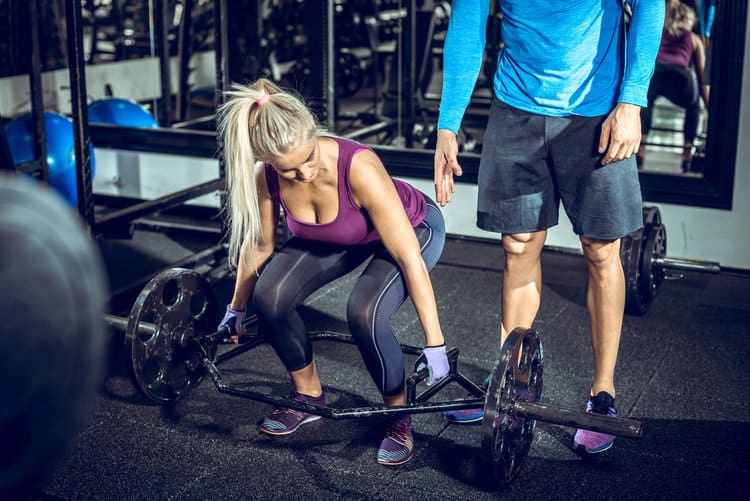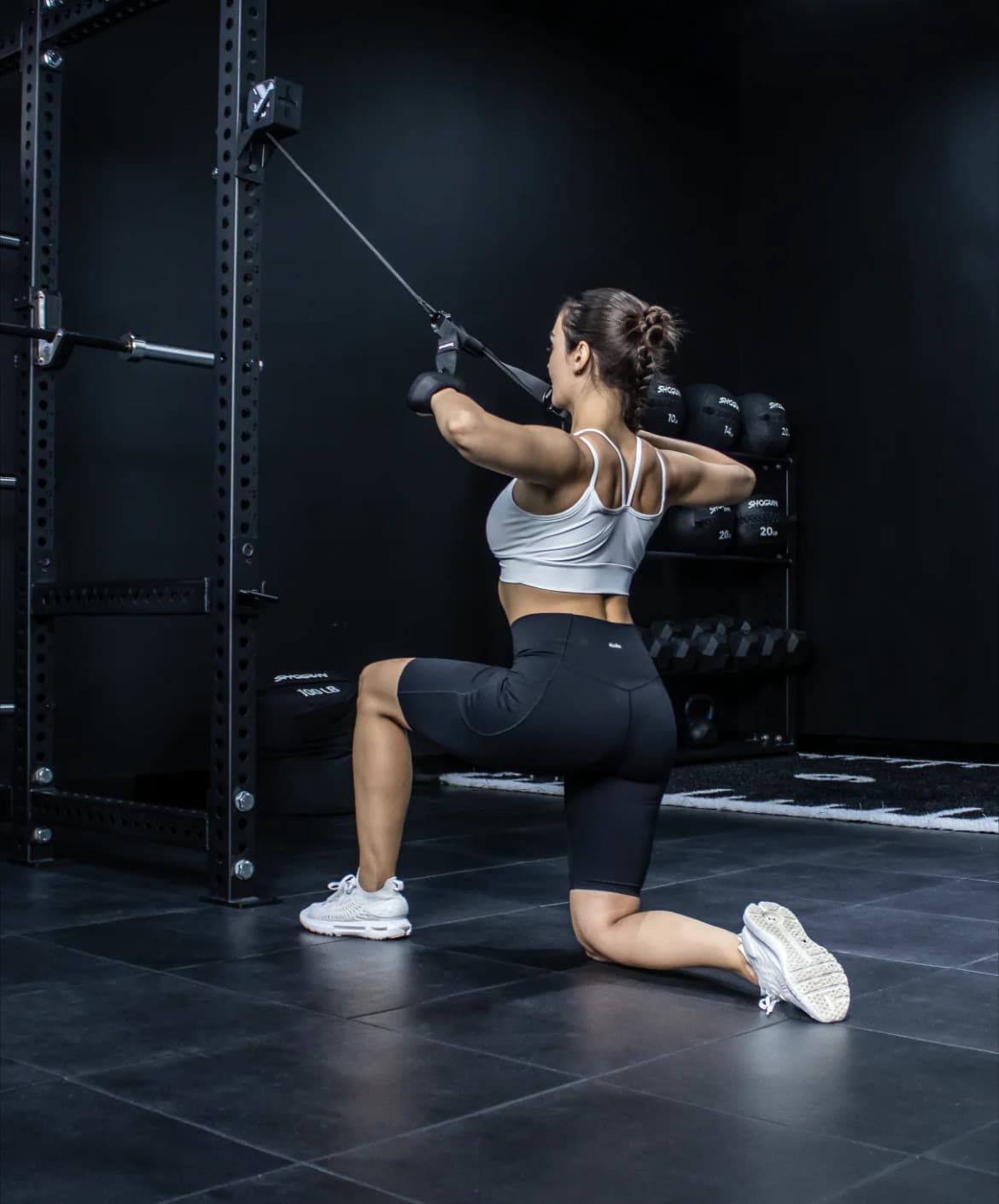Trap bar jumps are in nearly every athlete’s training program, and for good reason!
They’re a super effective way of building power and improving speed, and a must-do if you’re trying to level-up your game and become a better athlete!
We’ll break down exactly how to do trap bar jumps, why they’ll help you, things to look out for, and more.
Let’s begin!
How To PROPERLY Perform Trap Bar Jumps
The trap bar jump is very similar to a trap bar deadlift, except you explode THROUGH the rep and actually jump with the weight.
You can do these with a closed or open trap bar, and I recommend doing them with bumper plates rather than standard plates to avoid breaking them or cracking the floor (otherwise your gym owner will yell at you).
1. Get Into Your Setup Stance
If you’ve done a trap bar deadlift, the setup is pretty much the same.
Stand in the middle of the trap bar with your feet about shoulder-width apart.
Grab the handles and get into a deadlift stance, bending at the ankles, hips, and knees.

Take a deep breath into your belly and brace your core.
Sightly pull up to take the slack out of the bar, but don’t lift the weight off the floor yet – this will help you avoid yanking on the bar and making the rep messy!
2. Explode Into A Jump
Now you’re ready to jump!
Explode through your feet, trying to rip the weight off the floor as hard as you can.
You should extend through your ankles, knees, and hips at the same time, and try to get as much height as possible.

If your feet don’t leave the ground, you’re either using too much weight or not pushing hard enough – the whole idea here is that you want to jump up!
Also, don’t shrug your shoulders up – your arms should act as more of a rope and not really do anything except hold on to the weight.
3. Land Safely
This is one of the more important points.
You want to land and let the weight bring you back to your starting position – don’t try to fight it and stay standing up!
That’s not saying you should collapse and drop to the ground, but letting the weight pull you back down in a controlled way is going to stop any extra stress or strain going through your muscles, ligaments, and tendons.
Start and stop in the same position!
Trap Bar Jumps Sets & Reps
You want to do more sets and less reps for trap bar jumps – it’s quality over quantity with these – which will help you minimize fatigue and get the absolute most out of each rep.
Trap bar jumps aren’t for maxing out or making your muscles fail, so we need to adjust the reps and sets accordingly.
.
Try doing 5-10 sets of 2-5 reps, with each rep being done as fast and powerful as possible before taking a 2-4 minute break between sets.
You want to focus and have perfect form for each rep, making sure you also land properly every time.
What Weight To Use For Trap Bar Jumps?
Trap bar jumps should feel a lot lighter than you’re used to with regular trap bar deadlifts.
It’s also good to look at what your goals are:
.
Use 50-60% of your 1-rep deadlift max if you want to maximize how much force you can create.
Use 30-40% of your 1-rep deadlift max if you want build the speed of which you create force.
You don’t have to go crazy with the math here, but shoot for a mix of 30-60% of your 1-rep deadlift max to get well-rounded results – for example focus 1 workout on 30%, and the next workout closer to 60%!https://boxingscience.co.uk/trap-bar-jumps/
Benefits Of Trap Bar Jumps – Why Do ‘Em?
Trap bar jumps are super easy to learn, making them a great option for anyone that needs to build power quickly without wanting to learn a new skill (like olympic lifts).
Not only are they simple, but highly effective too.
A study showed that trap bar jumps have a higher ceiling when it comes to power output as compared to olympic lifts and squat bar jumps…https://pubmed.ncbi.nlm.nih.gov/22446664/
Which really upsets what a lot of people have believed in the past – that olympic lifts are number 1 for explosiveness.
The thing is, your body doesn’t really care what type of exercise you are doing, but adapts to what the exercise is challenging the body with…
Trap Bar Jumps Are Superior For Power Output
In this case, the trap bar jump challenges the body with power output more so than olympic lifts and squat bar jumps do, and allows you to train producing more force.
It turns out that jumping produces more power than olympic lifts do in general, making jump training necessary for increased explosiveness.https://www.ncbi.nlm.nih.gov/pmc/articles/PMC3739858/
Taking that a step further, doing jump training with added resistance increases peak power output even MORE (we’ll talk about why trap bar jumps are best for this), making trap bar jumps the perfect power-building exercise!https://pubmed.ncbi.nlm.nih.gov/8289617/
Now there’s a limit with that – at some point you lift too much weight that stops you from jumping and actually lowers your power output.
That’s where the 30-60% of your 1-rep deadlift max comes in – it’s light enough to jump with but also optimizes your power output!
Trap Bar Jumps Are The Safest & Easiest Option
Trap bar jumps have one of the lowest skill requirements and are very easy to do safely.
Olympic lifts are notoriously tricky to get good at, and you might hit some early barriers with mobility problems that don’t let you get into some of the positions you need.
Trap bar jumps are simple: you bend down, grab the handles, and jump up.
It’s easier to mess up on something like heavier barbell squat jumps, which have the weight resting on your upper back – your spine might not like that much if you land wrong!
With the trap bar jumps, you can quickly learn how to do them safely without much skill, and it’s easier to dump the weight and land properly than barbell jump squats.
Trap Bar Jumps Are Perfect To Improve Triple Extension
Triple extension is a really important concept in the athletic world.
It refers to your ankles, hips, and knees simultaneously extending, which is a pattern that is rooted in nearly all athletic movements!

Trap bar jumps are an awesome exercise that builds this movement pattern, creating the foundation of an explosive and powerful athlete.
Specificity is key, and trap bar jumps are one of the several great exercises to build triple extension!
Trap Bar Jump Drawbacks
There aren’t many drawbacks to trap bar jumps, and they mostly have to do with HOW you perform them.
It’s Easy To “Cheat” The Weight
I mentioned this earlier, but you need to avoid shrugging the weight up at the top of your rep.
Too many people try to turn this into a partial clean, beginning with the shoulder shrug – keep them down and focus purely on driving through your legs!
People Love To Ego Lift With Trap Bar Jumps
It’s hard to take 30-60% of your 1-rep max and take the exercise seriously – most of us hate dropping the weight for any reason, but it’s super important if you want to build the most explosiveness and power possible!
You Need To Learn To Land Properly
You’ll likely want to keep your legs straight when you land, especially when the weight is so light and you can easily stay stiff.
But that can lead to injuries – let the weight drag you back down into your starting position without fighting it!
Trap Bar Jump Alternatives
There might be a reason you can’t or don’t want to do trap bar jumps – although I suggest seriously considering it if you can!
Your gym might not have a trap bar or you only have a barbell at home, in which case check out these alternatives!
Trap Bar Jumps vs. Power Cleans
Power cleans are a really great exercises, and are similar to trap bar jumps in certain cases.
But one of the big differences is that Olympic lifts like power cleans require a lot more technique and mobility, which can act as a barrier.
A study also found that peak power in the power clean is generated when using at least 70% of your 1-rep max, which is a whole lot heavier than the trap bar jump using 30-60%.https://www.researchgate.net/publication/278042537_The_Optimal_Load_for_Maximal_Power_Production_During_Lower-Body_Resistance_Exercises_A_Meta-Analysis
This isn’t to say that power cleans are a bad exercise – they still develop power – but there is a greater barrier to learning technique and building up enough strength to generate peak power as compared to trap bar jumps.
Plus, that study showed trap bar jumps generate a higher peak power anyways, making it a better bang-for-your-buck.
Trap Bar Jumps vs. Barbell Jump Squats
Both trap bar jumps and barbell jump squats are very specific to jumping, so they should have the same effectiveness, right?
Well, almost…
A study looked at where your load should be in order to produce the most power, and found that the trap bar jump was better suited for that:
The results suggest that weighted vertical jumps should be performed with the external load positioned at arms’ length rather than on the shoulder when attempting to improve lower-body muscular performance.https://pubmed.ncbi.nlm.nih.gov/22446664/
Both are fairly similar in that you’re jumping up, but that difference of weight hanging beside you vs. sitting on your back allows you generate more power.https://pubmed.ncbi.nlm.nih.gov/21659894/
It also tends to feel a little bit better than having the weight on your back when you land – nevertheless, squat bar jumps are still a great exercise for powerful legs!
Trap Bar Jumps – Muscles Worked
Trap bar jumps will hit almost your entire body!
You’ll mainly feel it in your glutes, hamstrings, quads, and calves, due to the triple extension mechanism and it being a lower-body dominant exercise.
But you’ll also give your forearms and traps a tough workout since you have to hold on to the trap bar and keep your upper body upright!
What’s The Verdict?
Trap bar jumps are one of the best – if not THE best – exercise to build powerful legs.
They generate the most peak power when compared to olympic lifts and squat bar jumps, and are super easy to learn!
The low barrier to entry makes this a must-do if you’re wanting powerful legs, focusing on more sets with low reps and light weight to minimize fatigue and generate the most peak power.
Remember, each rep should be done with great form and with as much speed as you can – jump for the moon!























